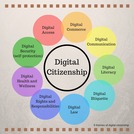
This is a lesson on the topic of Digital Citizenship.
- Subject:
- Technology
- Material Type:
- Homework/Assignment
- Author:
- Joy Whitlow
- Date Added:
- 07/08/2024

This is a lesson on the topic of Digital Citizenship.

The lesson plan, designed for 9th-grade students, focuses on digital citizenship, encompassing online safety, cyberbullying, privacy settings, and phishing. Students learn the importance of responsible digital behavior and practical strategies for staying safe online. They explore the types and impact of cyberbullying, understand the significance of privacy settings, and discover how to protect themselves against phishing attempts. The lesson concludes with students creating personal digital citizenship pledges to guide their online interactions, emphasizing responsible and ethical behavior in the digital world.
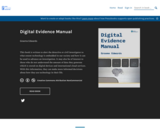
This book is written to alert the detective or civil investigator to what extent technology is embedded in our society and how it can be used to advance an investigation. It may also be of interest to those who do not understand the amount of data they generate which is stored on digital devices and international cloud services. With this information, they can make more informed decisions about how they use technology in their life.
It is unlikely a connected person can conduct many activities in their day without technology accumulating and storing data created by their activities and online interactions with other people. Technology is a driving feature of many individuals’ lives, but few users understand what is happening behind its functional level. Large amounts of personal data are being generated from the multitude of technological devices we interact with each day that are stored by manufacturers and service providers and used for profiling and sale. Once this data is generated and stored, evidence of activity remains on the devices and/or corporate servers where it can be used to build a profile on an individual including their personality which becomes more accurate as more data is accumulated.
Where people forget what they have done, technology never does.
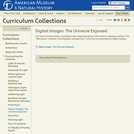
For most of human history, recording a star meant describing it with words or drawing a picture. The 19th-century invention of photography changed that—only to be revolutionized by digital imaging. This Moveable Museum article, available as a six-page printable PDF file, takes a look at the technology of digital imaging. It discusses how digital images are pictures stored as numbers and explains how computer manipulation can enhance images and reduce distortion. Some suggested resources are provided for further research.
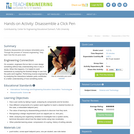
Students disassemble and analyze retractable pens. Through the process of "reverse engineering," they learn how the ink pens work.
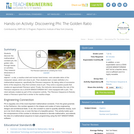
Students discover the mathematical constant phi, the golden ratio, through hands-on activities. They measure dimensions of "natural objects"—a star, a nautilus shell and human hand bones—and calculate ratios of the measured values, which are close to phi. Then students learn a basic definition of a mathematical sequence, specifically the Fibonacci sequence. By taking ratios of successive terms of the sequence, they find numbers close to phi. They solve a squares puzzle that creates an approximate Fibonacci spiral. Finally, the instructor demonstrates the rule of the Fibonacci sequence via a LEGO® MINDSTORMS® NXT robot equipped with a pen. The robot (already created as part of the companion activity, The Fibonacci Sequence & Robots) draws a Fibonacci spiral that is similar to the nautilus shape.

In this lesson, students will learn how cosmic rays were discovered and what they are - including their size and speed. Includes background information for the teacher, questions, activities and information about student preconceptions. This is lesson 1 of 4 from "The Cosmic Ray Telescope for the Effects of Radiation (CRaTER)."

This is an activity about the Hubble Deep Field image, an observation of one small area of sky that contained no previously-detected objects. The long time exposure of this image allows us to detect some of the most distant objects seen in our Universe. Learners will view an image of the Hubble Deep Field and identify how many distant galaxies are visible as well as the types of galaxies they might be. Observations will be taken a step further to infer predominant age of a galaxy and determine if there are any trends in age (color) versus galaxy size or type and, ultimately, if the distant Universe appears relatively uniform. This activity is Astronomy Activity 4 in a larger resource, titled "Space Update."
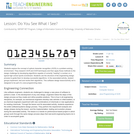
Students explore the concept of optical character recognition (OCR) in a problem-solving environment. They research OCR and OCR techniques and then apply those methods to the design challenge by developing algorithms capable of correctly "reading" a number on a typical high school sports scoreboard. Students use the structure of the engineering design process to guide them to develop successful algorithms. In the associated activity, student groups implement, test and revise their algorithms. This software design lesson/activity set is designed to be part of a Java programming class.
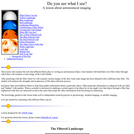
This is an online lesson which introduces the concept of astronomical filters and their connections to imaging different objects in space. Learners will explore perceptions of images as seen using different colors of light, construct a filter wheel, and practice investigating various astronomical images using the filter wheel. This material was designed to highlight how filters are useful to astronomers and show how a real astronomical telescope uses filters to image the Sun.

In this episode of Art School, visit Paccarik Orue in the studios of Rayko Photo Center where he is currently an Artist-In-Residence. Tag along with Orue as he makes photographs in the Iron Triangle neighborhood of Richmond, California. From 2009-2011, Orue photographed residents and structures there for his book titled, There Is Nothing Beautiful Around Here.
Orue also introduces us to his latest body of work, which is centered in the city of Cerro de Pasco in his home country of Peru. Cerro de Pasco is one of the highest cities in the world, perched atop the Andean Mountains. Even though he has returned to his homeland, Orue feels like an outsider.
In the second video, learn how to scan, clean and color-correct medium format film, as Orue demonstrates the necessary steps for digitizing color film negatives.

In this interactive activity from the Building Big Web site, think like an engineer and use your knowledge of dome design to match the right type of dome to the right location in a fictitious city.

In this activity, students use the binary number system to transmit messages. Two flashlights are used to demonstrate how astronomy spacecraft to transmit images and other scientific data to Earth. This activity is part of Unit 4 in the Space Based Astronomy guide that contains background information, worksheets, assessments, extensions, and standards.

In this activity, students simulate how light collected from a space object converts into binary data and reconverts into an image of the object. A pencil and paper activity demonstrates how astronomical spacecraft and computers create images of objects in space. This activity is part of Unit 4 in the Space Based Astronomy guide that contains background information, worksheets, assessments, extensions, and standards.
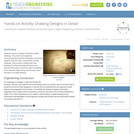
Students practice creating rudimentary detail drawings. They learn how engineers communicate the technical information about their designs using the basic components of detail drawings. They practice creating their own drawings of a three-dimensional block and a special LEGO piece, and then make 3D sketches of an unknown object using only the information provided in its detail drawing.
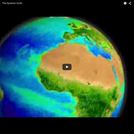
This movie provides an 18-minute introduction to how NASA is observing our ever-changing planet. On the The Dynamic Earth DVD Web page you can download the video as an iPod or iPhone version, as well as an AppleTV/Full resolution version, and access a glossary and links to related Web sites.
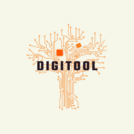
E-Magazines were created by the team of digitool to disseminate knowledge about new technologies through our own experience in mobilities.
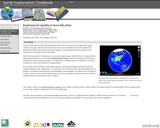
DATA: NASA Aura nitrogen dioxide data. TOOL: Google Earth. SUMMARY: Learn about photochemical smog. Explore the relationships among human population density, nitrogen dioxide concentrations, and geography.
(Note: this resource was added to OER Commons as part of a batch upload of over 2,200 records. If you notice an issue with the quality of the metadata, please let us know by using the 'report' button and we will flag it for consideration.)
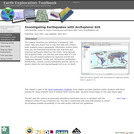
DATA: Recent and Historical Earthquake Data. TOOL: ArcExplorer Java Edition for Education GIS. SUMMARY: Explore earthquake data and import them into a Geographic Information System (GIS). Analyze the data to predict where the next big earthquake will occur.
(Note: this resource was added to OER Commons as part of a batch upload of over 2,200 records. If you notice an issue with the quality of the metadata, please let us know by using the 'report' button and we will flag it for consideration.)
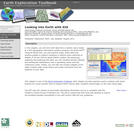
DATA: Seismic Wave Model Output. TOOLS: My World GIS, Microsoft Excel. SUMMARY: Examine seismic wave data in a Geographic Information System (GIS). Analyze wave velocities to infer the depth of the crust-mantle boundary.
(Note: this resource was added to OER Commons as part of a batch upload of over 2,200 records. If you notice an issue with the quality of the metadata, please let us know by using the 'report' button and we will flag it for consideration.)